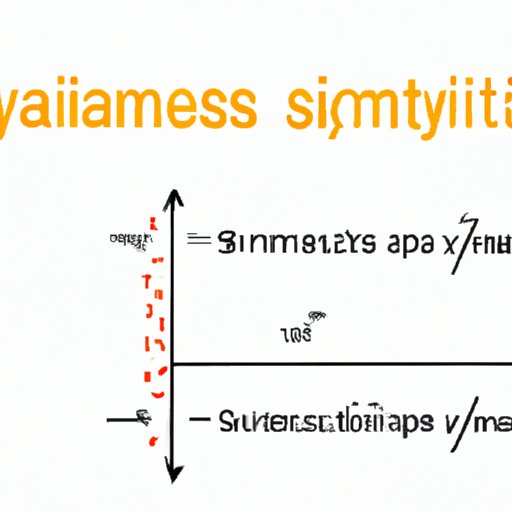
I. Introduction
Asymptotes are an essential component of understanding the behavior of mathematical and graphical functions. A function may behave differently as it approaches a particular value or infinity. Horizontal and vertical asymptotes assist in identifying these cases. This article will provide a step-by-step guide to finding both horizontal and vertical asymptotes in various types of equations.
II. Understanding Asymptotes: Theory and Concept
In mathematical functions, the value of a variable changes as the variable changes. Asymptotes are the values at which the output of a function has special behaviors. Specifically, they indicate the behavior of the function as it approaches infinity or zero. A vertical asymptote is a boundary for a function that restricts the domain of a function. A horizontal asymptote is the value that a function approaches as the x-value approaches infinity or negative infinity.
Limit plays a vital role in determining asymptotes. The limits of a function must be evaluated both before and after it reaches a vertical asymptote. The horizontal asymptote is the limit of a function as x approaches infinity.
III. Finding Horizontal Asymptotes: A Step-by-Step Guide
Horizontal asymptotes are determined by the degrees of polynomial functions, which can be simplistically defined as the highest exponent of a function. For instance, in the equation y=9x5+ 4x3+ 2, the degree of y is 5. In polynomial functions, horizontal asymptotes exist only when the degrees of numerator and denominator polynomial functions are the same. If the numerator is of a higher degree, the function will have an oblique asymptote.
A Rule of thumb is that if the degree of the numerator is greater than the denominator, there is no horizontal asymptote. However, if the degree of the denominator is most significant, all horizontal asymptotes are at y=0. When the degrees of the numerator and denominator are equal, the horizontal asymptote is at y = a/b, where a and b are the leading coefficients of the numerator and denominator, respectively.
For example, let’s take an equation y = (4x3 – 8x2 + 2x – 1) / (2x3 + x2 – 1).
Step 1: Determine the degrees of polynomials in the numerator and denominator.
Step 2: If both degrees are the same, divide the leading coefficient of the numerator by the leading coefficient of the denominator, and you will get the horizontal asymptote.
Step 3: If the degree of the numerator is greater than the degree of the denominator, no asymptotes exist.
The answer is y = 2.
IV. Finding Vertical Asymptotes: A Step-by-Step Guide
Rational functions often have vertical asymptotes. The primary reason behind this is that when a denominator of a rational function equals 0, the value of the function becomes invalid.
To solve for vertical asymptotes, one must examine the denominators and set them equal to zero. Afterward, one can solve for x to determine the vertical asymptotes. It’s crucial to note that the numerator’s degree doesn’t matter in this case.
For example, let’s consider y = (2x + 1) / (x – 4) as an equation.
Step 1: Determine all x-values that would make the denominator equals zero.
Step 2: We would then solve the equation x – 4 = 0 to determine which x values will create vertical asymptotes.
The answer here would be 4. This means that the equation has a vertical asymptote at x = 4.
V. Tricks and Strategies to Identify Asymptotes
It’s not always easy to determine vertical and horizontal asymptotes. Therefore, certain methods can help to simplify this process. For instance, examination of the limit of an equation at infinity and negative infinity can be helpful in analyzing vertical and horizontal asymptotes. However, It’s important to remember that these limits will only work for rational and exponential functions that vanish or explode; in cases where they do not, the examination of degrees would be more effective.
In some cases, logs and exponentials equations have asymptotes. It can often be difficult to understand exactly where these asymptotes exist; however, certain strategies that can help you recognize them are:
- The vertical asymptote of the logarithmic equation would occur when the value inside the log function is zero.
- The horizontal asymptote of an exponential function tends to be at y = 0 as the base of exponential function gets high.
VI. Exploring the Relationship between Asymptotes and Limits in Calculus
Calculus can offer an alternative approach to finding exact values for asymptotes in mathematical functions. An extension of limits, called L’Hopital’s rule, is a proven tactic in analyzing functions where the limit at a point equals the ratio of the derivative of two functions. This rule often simplifies equations to enable easy determination of asymptotes in various functions. An alternative approach is the use of an algebraic algorithm called synthetic division, a powerful strategy for evaluating a polynomial function’s standard form.
VII. Common Mistakes to Avoid When Determining Asymptotes
Here are some examples of common errors when determining the asymptotes and how to avoid them:
- Ensure to factor out the equation before attempting to identify asymptotes.
- Determine all x values that can make it equals zero before solving for the asymptotes.
- Ensure to perform a degree check to identify horizontal asymptotes.
- Avoid assuming that graphs with non-zero horizontal asymptotes are symmetrical.
- Avoid forgetting to reduce all rational function equations’ zero values after finding vertical asymptotes.
VIII. Conclusion
Determining asymptotes is a fundamental skill in mathematical functions and graphical representations. With the step-by-step guide provided in this article, it is possible to identify horizontal and vertical asymptotes in different types of equations. Additionally, through understanding the role of degrees and the limits in calculus, it is possible to calculate exact values of asymptotes. Avoiding common mistakes and employing useful strategies will make it easier for you in identifying asymptotes. With a practical and logical approach, you can confidently identify the asymptotes of any function.





